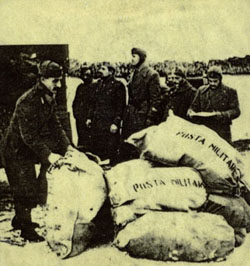
Corpo di Spedizione Italiano in Russia
Germany invaded Russia on 22 June 1941. Four days later 60,000
Italian soldiers were parading in Verona on their way to Russia.
Mussolini boasted that his troops were superior to the Germans
in men and equipment. This force was named the "Corpo di Spedizione
Italiano in Russia, C.S.I.R." (Italian Expeditionary Corps in Russia). VIII Corpo d'Armata The newly arrived Divisions Sforzesca, Ravenna and Cosseria made up the II Corps. The German 294th and 62nd Infantry Divisions were attached to what became known as the Italian 8th Army. 
"No march on Moscow without the march on Rome."
In July 1942, General Italo Gariboldi took over command of the
8th Army. Mussolini also sent two Blackshirt Brigades the "3
Gennaio and 23 Marzo." 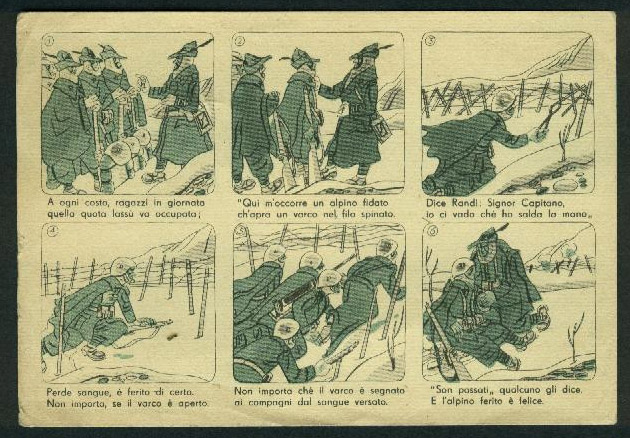
Interesting propaganda card mailed by a member of the Pasubio Division illustrating drawing images of Alpini troops fighting in the harsh winter climate of the Eastern Front.
As was expected on 16 December 1942, the Soviets launched "Operation
Small Saturn." Prepared for the attack were four Soviet Armies,
with a total of 425,426 men, 1030 tanks and almost 5000 artillery
guns. 
Very nice written letter from the Legione Tagliamento. Declaration/Certification from a Superior Officer that the soldier has been wounded during a fire that occurred in a military facility. Declaration has C.S.I.R. seal and sign by the Comander of the Legione Tagliamento. | |||||||
|
Italian CSIR Postal History
On
5 July 1941, a Special Military Postal Service for the East
was created for the CSIR, which was set up in Cremona and was
later transferred to Brescia, Italy. Postcards and covers up
to 250gms were free of charge to all military personnel.
|
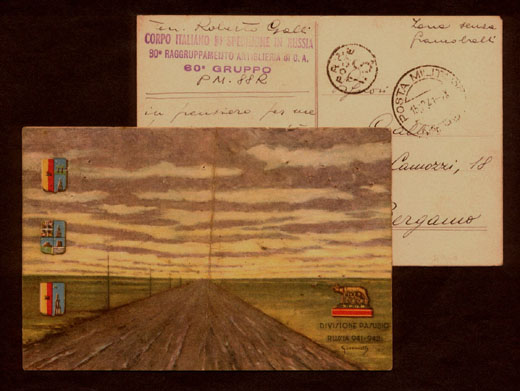
By spring 1942, the service became more efficient and regular service was reduced to 12-15 days. On 15 August 1941, airmail service was added. Airmail service was initially collected at Krivoi Rog and Dniepropetrovsk, Ukraine. Usually mail from the front was transported by rail or truck to military airfields located in Russia, which was then picked up by military aircraft and transported to the logistic sections (PM 88/102). From there a commercial Airline "Ala Littoria" was used to transport mail to the homeland. All such letters had to be submitted for censorship. Sealing tapes with the word "VERIFICATO PER CENSURA" were applied to envelopes that were opened. In addition some mail were censored with a double ring circular cancel.
| 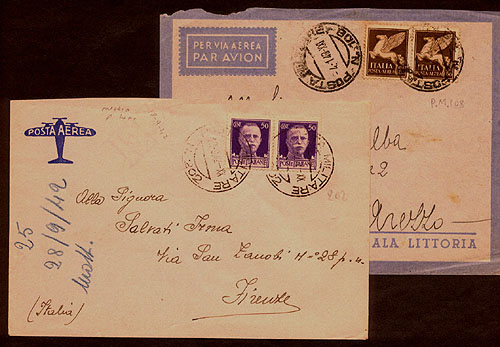
|
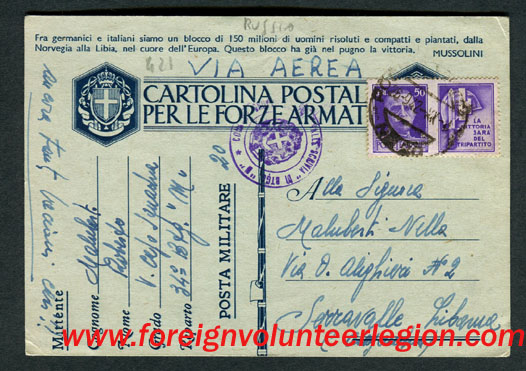
Illustrated is a scarce military airmail card dated September 1942 sent by a member of the elite Black Shirt volunteer 34th Battalion Mussolini. Note: I have a nice article relating to the C.S.I.R. & 8th Army military and postal history with list of military three digit postal numbers assigned to Italian units that fought on the Eastern Front as well as illustrations for those interested please contact me for details. There will be a small fee charged, which covers postage and handling. |
[ Front Page ] [ Top ] [ Previous Page] [Next Page]
